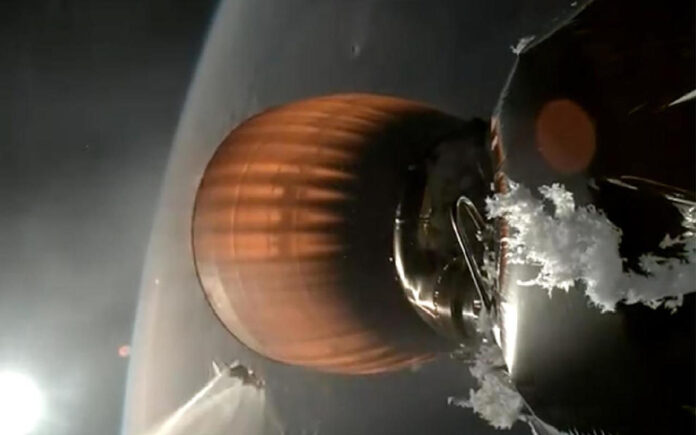Washington: SpaceX’s reliable Falcon 9 rocket was grounded by the U.S. Federal Aviation Administration (FAA) on Friday following a malfunction that led to the loss of its payload of Starlink satellites. This marks the first failure in over seven years for the rocket, which is pivotal to the global space industry.
Approximately an hour after the Falcon 9 launched from Vandenberg Space Force Base in California on Thursday night, the rocket’s second stage failed to reignite. This caused the deployment of its 20 Starlink satellites on a shallow orbital path, ensuring they will reenter Earth’s atmosphere and burn up.
The attempt to reignite the engine “resulted in an engine RUD for reasons currently unknown,” SpaceX CEO Elon Musk wrote early on Friday on his social media platform X, using the industry term Rapid Unscheduled Disassembly, which typically means explosion.
The Falcon 9 will remain grounded until SpaceX investigates the cause of the failure, implements necessary fixes, and receives the FAA’s approval. The agency stated that this process could take several weeks or months, depending on the issue’s complexity and SpaceX’s plan to address it.
This mishap ended the success streak of more than 300 consecutive missions, a testament to SpaceX’s dominance in the launch industry. Many countries and space companies rely on SpaceX, valued at approximately $200 billion, to send their satellites and astronauts into space.
Musk stated that SpaceX was updating the software of the Starlink satellites to force their on-board thrusters to fire harder than usual to prevent a fiery atmospheric re-entry. “Unlike a Star Trek episode, this will probably not work, but it’s worth a shot,” Musk said.
SpaceX assured the public that the satellites pose no threat and that they would make their reentry, appearing as streaks of light across the sky. “Shooting stars,” Musk said in response to SpaceX’s post. The company’s statement confirmed that the satellites would “re-enter Earth’s atmosphere and fully demise.”
NASA said on Friday that it monitors all of SpaceX’s Falcon 9 missions. “SpaceX has been forthcoming with information and is including NASA in the company’s ongoing anomaly investigation to understand the issue and path forward,” a U.S. space agency spokesperson said.
SpaceX revealed that the second stage’s failure occurred after engineers detected a leak of liquid oxygen, a propellant.
Also Read | Fatal Incident: Nigerian School Building Collapse Claims 22 Lives
A Remarkable Streak
The failure happened during Falcon 9’s 354th mission and was the first since 2016, when a rocket exploded on a launch pad in Florida, destroying an Israeli communications satellite. “We knew this incredible run had to come to an end at some point,” Tom Mueller, SpaceX’s former vice president of propulsion who designed Falcon 9’s engines, replied to Musk on X. “… The team will fix the problem and start the cycle again.”
The grounding of Falcon 9 will likely affect SpaceX’s launch schedule. The rocket achieved a record 96 launches last year, surpassing any other country’s annual launch total. China, a major space rival, launched 67 missions in 2023.
“It is extremely rare for Falcon to fail. They have a much better rate than almost any other rocket developed in terms of the success of their mission,” said Will Whitehorn, chair of the venture capital firm Seraphim Space Investment Trust.
Although Thursday night’s Falcon 9 flight was an in-house mission, the grounding is expected to impact upcoming SpaceX customer missions. Falcon 9 is the only U.S. rocket capable of sending NASA crews to the International Space Station. NASA had planned to launch its next astronaut mission in August, with SpaceX’s Crew Dragon astronaut capsule atop the rocket.
Also Read | Nepal Landslide: Slim Hope for Survivors as Rescue Efforts Continue
NASA is also assisting with unrelated issues affecting Boeing’s Starliner spacecraft, which is undergoing a test mission to become NASA’s second astronaut transport to orbit alongside Crew Dragon.
SpaceX was set to launch the Polaris Dawn Crew Dragon mission as early as July 31, sending four private astronauts into orbit for a few days to conduct the first commercial spacewalk using newly designed spacesuits. Jared Isaacman, head of the Polaris program and a mission crew member, expressed confidence in SpaceX’s ability to recover quickly. “As for Polaris Dawn, we will fly whenever SpaceX is ready and with complete confidence in the rocket, spaceship and operations,” Isaacman wrote on X.
Musk added, “We will investigate the issue and look for any other potential near-misses.”
Since 2018, SpaceX has launched about 7,000 Starlink satellites of various designs into space for its global broadband internet network. Industry analysts estimate that the satellites lost in Thursday’s mission could be worth at least $10 million combined.



